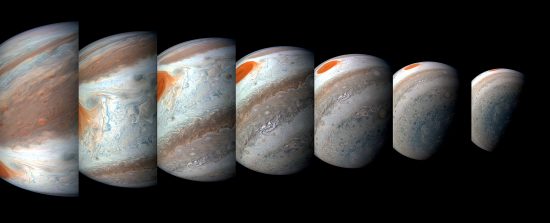
From left to right, this sequence was taken on April 1, 2018 as the spacecraft performed its 12th close flyby of Jupiter. Image Credits: NASA/JPL-Caltech/SwRI/MSSS/Gerald Eichstädt/Seán Doran.
Jan 2, 2019
Jupiter is electrodynamic.
Many Pictures of the Day discuss the planet, Jupiter—especially its electromagnetic interaction with its moons and the rest of the Solar System. Jupiter’s magnetosphere extends for almost 650 million kilometers; even beyond Saturn’s orbit.
Bands of radiation, similar to the Van Allen radiation belts, except thousands of times greater, surround Jupiter. The most energetic bands radiate in radio frequencies. That plasma radiation led to the discovery of Jupiter’s magnetic field. However, the maverick scientist, Immanuel Velikovsky, predicted Jupiter’s magnetic field in 1953.
On December 21, 2018 Juno was a mere 5,053 kilometers above Jupiter’s clouds, traveling at 207,287 kilometers per hour, marking Juno’s 16th low-altitude pass. Juno’s elliptical 53-day orbit includes those close passes, as it follows a track extending from Jupiter’s north pole to its south pole.
According to a recent press release, Jack Connerney, Juno deputy principal investigator from the Space Research Corporation wrote:
“This will provide coverage of the planet every 11.25 degrees of longitude, providing a more detailed picture of what makes the whole of Jupiter tick.”
Back in 1995 the Galileo orbiter discovered a dipole magnetic field like the one surrounding Earth. The signature of Ganymede’s flux tube, the electric current that connects it with Jupiter, can be seen in the aurora at the poles. Galileo discovered electric charge flowing around the planet, just as Electric Universe advocates predicted. Also, as previously written, Jupiter’s moon Io dissipates more than 2 trillion watts of power.
An electrical connection between Jupiter and its moons means that Jupiter is in an electrodynamic relationship with the Sun. Since Jupiter’s auroral storms are seen when solar activity is low, it is assumed that its moons might provide a key to understanding planetary bodies with magnetic fields.
Jupiter is more electrically active than consensus models predicted. Instead of a 5 gauss magnetic field, Juno detected a 9 gauss field, compared to Earth at .5 gauss. The field is also quite irregular, suggesting to astrophysicists that there is some kind of nonconformity.
According to a recent press release, NASA extended funding for the Juno mission until 2022. As it stands, spacecraft operations will end in July 2021 with incineration taking place sometime in 2022. The extension is largely due to a concern with its fuel delivery system. Instead of orbiting Jupiter every 14 days, Juno is in a 53 day orbit.
Stephen Smith












